Fed cuts rates, gold bounces higher after election dip
Posted onFed Cuts Interest Rates for Second Time in 2024 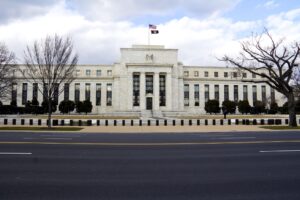
As expected, the Federal Reserve delivered its second interest rate cut of 2024 on Thursday. The central bankers updated their policy statement saying: “The Committee judges that the risks to achieving its employment and inflation goals are roughly in balance.” The Fed cut its key interest rate by 0.25 percentage points to 4.50-4.75%.
How did markets react? Gold traded $32.50 higher Thursday afternoon at $2,703.30. Silver also traded higher on the day, up .74 at $32.03. The stock market generally rose in lackluster trading, Treasury yields fell, and the U.S. dollar slid lower.
What about the election? Reporters asked Federal Reserve Chair Jerome Powell about the elephant in the room: will Donald Trump’s election victory shape future Fed decisions? At the post-meeting press conference, Fed Chair Powell pushed back on those ideas.
Powell said the election will have “no effect” on the Fed’s policy decisions near term. “Many things affect the economy,” Powell told reporters. “We don’t guess, speculate or assume” what the potential economic impact of what the next administration could be.
What could lie ahead? On Thursday, the central bankers were essentially following through on the interest rate cut they signaled at their September meeting. But economists are warning the future interest rate cuts may not be as speedy or deep as previously expected. Some of President-elect Trump’s policies like rising tariffs could potentially reignite inflation. According to a recent Barron’s Big Money Poll, the resurgence of inflation was the number one risk over the next six months.
Recent economic reports have shown red flags. The October jobs report revealed only 12,000 new jobs last month, well below expectations for 105,000 jobs created. The most recent inflation data shows higher prices are still sticking around – especially when you factor in food and gas. The Fed’s preferred inflation gauge, the personal consumption expenditure (PCE) rate, revealed a 2.7% annual increase in September.
What does this mean for gold? Investors swiftly bought the election dip in gold and precious metals are climbing on Thursday afternoon. Gold and silver are turning out double-digit gains in 2024 as investors turn to the safety and security of precious metals. With new questions on the horizon about the potential resurgence on inflation, gold will continue to have the wind at its back.
Gold broke through the $2,700 an ounce barrier to a new record high for the first time ever recently. The number of firms that now project gold gains to $3,000 an ounce are too many to count.
Gold’s role as currency and an asset to protect, preserve and grow your wealth has lasted for centuries and shows no signs of losing its appeal. If you have been thinking about increasing your allocation to gold, there’s never been a better time. It’s easy to increase your wealth protection, why not do it today?
Want to read more? Subscribe to the Blanchard Newsletter and get our tales from the vault, our favorite stories from around the world and the latest tangible assets news delivered to your inbox weekly.
Trump Wins! What Does This Mean for Precious Metals?
Posted onAmericans across the nation were sitting on the edge of their seats waiting for results on election night. We didn’t have to wait long. In the wee hours of the morning Wednesday, the AP called the election for Donald J. Trump after it became clear he won enough of the key battleground states to tip him over the 270 Electoral College votes needed to clinch the victory. Republicans also gained control of the U.S. Senate.
morning Wednesday, the AP called the election for Donald J. Trump after it became clear he won enough of the key battleground states to tip him over the 270 Electoral College votes needed to clinch the victory. Republicans also gained control of the U.S. Senate.
What does this mean for precious metals, the economy and your investments? Let’s take a look.
Initial Market Reaction
- Gold: The precious metal tumbled over $70 Wednesday in an initial knee-jerk market reaction to the swift victory. Gold had priced in some expectations that the election results would be drawn out and contested and could even trigger social unrest. Gold fell Wednesday as the market de-priced those concerns.
- Stocks: The U.S. stock market surged higher driven by expectations of deregulation and tax cuts that could increase corporate profits.
- Treasuries: The yield on the 10-year Treasury note climbed on expectations that Trump’s proposed tax cuts will add more to the deficit.
- Dollar: The U.S. dollar jumped higher on the Trump victory news amid ideas that inflation will move higher under his proposed tariff policies. The market dialed back expectations of future interest rate cuts—if the Fed needs to continue its fight against a renewed inflationary surge—which boosted the dollar.
These reactions however—are just that—initial reactions. In fact, gold already reclaimed half of Wednesday’s loss by Thursday morning. There are many longer-term ramifications from potential Trump policies that could positively impact precious metals—especially gold.
Why Trump’s Policies Will Be Good For Gold
There are three major buckets of Trump policies that long-term will be positive for gold.
- Trump’s proposed tariffs—which could lead to slower economic growth and higher inflation. Positive for gold.
- Trump’s proposed tax cuts—which could lead to a higher deficit. Positive for gold.
- Expectations for a changing world order—which could lead to increased safe-haven demand for precious metals amid geopolitical conflict. Positive for gold.
Why Tariffs Are Inflationary and Positive for Gold
President-elect Trump campaigned extensively on using tariffs in his second term. He used tariffs as president targeting a variety of imported goods from China. This time, Trump has proposed a 60% tariff on all goods imported from China and up to 20% on everything else America imports.
How tariffs work:
- In the U.S., there are 328 ports of entry across the country. At these ports, the Customs and Border Protection agents collects the tariffs.
- The American companies—those that are importing and bringing those goods into the country—are responsible for paying the tariff to the Custom and Border Protection agents.
- Those funds are then sent to the U.S. Treasury.
The American companies doing the importing typically pass these higher costs along to their customers in the form of higher prices—or more inflation.
The economic impact from tariffs—lower economic growth and higher inflation.
- Trump’s main tariff proposals, which are expected to encourage retaliation from the targeted countries are expected to trim economic growth by over a full percentage point by 2025 and increase inflation by more than 2 percentage points higher, according to the non-partisan Peterson Institute for International Economics.
Gold impact: If Trump enacts these tariffs, gold will continue to gain in price as the Fed will be fighting rising inflation and falling economic growth.
Why Tax Cuts Are Positive for Gold
On the campaign trail, President-elect Trump proposed a variety of tax cuts from eliminating taxes on tips to removing the taxes that some seniors pay on Social Security checks to lowering the corporate tax rate. Also, the Tax Cuts and Jobs Act of 2017 expires at the end of 2025 and Trump is expected to keep many of these tax cuts in place.
Gold impact: Eliminating these taxes would mean a loss of revenue for the federal government and an increase in the federal deficit. Concerns over the ongoing rise in the record-breaking federal deficit has been a key reason many investors have been piling into gold in 2024. Experts are warning that if the U.S. continues to increase its debt, the only solution is for currency devaluation. A paper currency devaluation would be extremely positive for a physical tangible asset like gold.
Why A Changing World Order is Positive for Gold
President-elect Trump will return to the White House with two escalating regional wars underway. A new authoritarian axis is arising which includes Russia and North Korea partnering in the war against Ukraine. China is providing support to Russia, North Korea and Iran—while it prepares its military for a potential invasion of Taiwan, which China has publicly told it’s military to be ready for by 2027. Israel’s war against Hamas has expanded with an invasion of Lebanon and direct missile strikes against Iran.
The chess pieces are moving around on the global stage and the role of America is expected to change—with perhaps a withdrawal of support for Ukraine.
As countries make new partnerships amid growing military conflict, the traditional role of American support for European security may be shifting in a second Trump administration.
The chess game has many moves left and there will be unexpected twists and turns in the months and years ahead. But, the changing world order has several deadly military conflicts still smoldering with the potential for new military conflict over Taiwan and economic trade wars in the months ahead.
Gold impact: Precious metals will continue to attract central bank, institutional and individual buyers as gold is a safe-haven currency that is beholden to no country or government. As a time-honored safe-have investment, gold will gain amid an increasingly unstable geopolitical world.
Want to read more? Subscribe to the Blanchard Newsletter and get our tales from the vault, our favorite stories from around the world and the latest tangible assets news delivered to your inbox weekly.
View from the Street: Money Managers Make the Case for Gold
Posted onWith gold up 31% since the start of the year, you may be curious, what do professional money managers think of gold and its outlook ahead?
Barron’s recently published its exclusive Big Money Poll: What’s Ahead for Stocks, Bonds and the Economy and money managers articulated the case for gold.
With many money managers voicing concern that the stock market is overvalued with the S&P 500 currently trading at 21 times 2025 estimated earnings, above its 5-year average—physical assets like gold stands out in today’s environment.
A Safe Haven
Gold was seen as a better haven than U.S. Treasuries for investors.
Steven Cucchiaro, CEO and chief investment officer of 3EDGE Asset Management told Barron’s: “I don’t think long-term bonds are a good hedge for market volatility,” adding that gold tends to be less correlated with stocks and bonds over the long-term.
Rising National Debt
It’s not just gold’s value as a safe haven, money managers highlighted the escalation of the U.S. national debt—which continues to rocket to new record highs, and currently stands at $35.8 trillion—as a reason to invest in gold.
Digging Deeper: The ratio of U.S. debt to gross domestic product is nearing 125%. What does this mean?
- “The debt-to-GDP ratio is a metric that compares a country’s public debt to its gross domestic product (GDP). It reliably indicates a country’s ability to pay back its debts by comparing what the country owes with what it produces,” according to Investopedia.
- “The higher the debt-to-GDP ratio, the less likely it becomes that the country will pay back its debt and the higher its risk of default.”
- “High debt-to-GDP ratios could be a key indicator of increased default risk for a country. Country defaults can trigger financial repercussions globally.”
“It’s math,” Rob Medway, managing general partner with MFLP told Barron’s. “Over time, if any country—even the U.S., the world’s dominant fiscal power—continues to increase its debt, the only solution is for currency devaluation.”
A paper currency devaluation would be extremely positive for a physical tangible asset like gold.
Inflation
According to the Barron’s survey, the resurgence of inflation was the number one risk facing the stock market over the next six months. Medway sees gold eventually climbing to $5,000 an ounce if inflation fears continue. Short-term, Medway sees runway for gold to hit $3,500 an ounce.
Other top risks for the stock market ahead include geopolitical turmoil, economic slowdown/recession and excessive stock market valuations.
With so many risks on the horizon, it’s no wonder so many investors are turning to the safety and security of gold today.
Want to read more? Subscribe to the Blanchard Newsletter and get our tales from the vault, our favorite stories from around the world and the latest tangible assets news delivered to your inbox weekly.
Legendary $50 Gold Piece: A Piece of Exciting California Gold Rush History
Posted onDuring the rough and tumble times of the California gold rush, people in the west desperately needed coins to buy everyday goods and services. Sure, large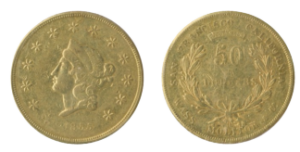 quantities of gold dust and nuggets were being discovered every day in the early 1850’s. Yet, there was no way to turn these newly discovered riches into coins in the west at that time. After all, the first California branch of the U.S. Mint didn’t open until 1854.
quantities of gold dust and nuggets were being discovered every day in the early 1850’s. Yet, there was no way to turn these newly discovered riches into coins in the west at that time. After all, the first California branch of the U.S. Mint didn’t open until 1854.
During the California gold rush and the ensuing economic boom, people were forced to use pinches of gold dust to pay for things. However, you surely can see how this method lacked uniformity. And the fat fingers from one merchant’s pinch could easily cost you more than expected!
Despite proposals to use paper currency to ease the coin shortage, Californians firmly rejected that idea. In fact, Article IV section 34 of the 1849 California Constitution outlawed the right for any bank to “make, issue, or put in circulation, any bill, check, ticket, certificate, promissory note, or other paper, or the paper of any bank, to circulate as money.”
Bottom line? Californians wanted hard currency.
Private coiners opened up
This created opportunity for enterprising businessman in the private coinage space. Samuel C. Wass and Agoston P. Molitor, Hungarian immigrants who had studied metallurgy in Germany, saw the opportunity and jumped on it.
Wass and Molitor opened an assay office on Montgomery Street in San Francisco in October, 1851.
It didn’t take long before the hardworking Wass and Molitor developed an extensive smelting operation and assay laboratory that was publicly lauded in the local newspapers for its modernity.
The public quickly embraced Wass and Molitor’s coins, which included $5, $10, $20 and $50 gold pieces. Their coins were considered good quality and miners who brought in nuggets and gold dust received fast service – their ore was turned into coins within 48 hours! Their gold pieces demanded a premium in circulation and were eagerly accepted in trade.
The end of an era
The San Francisco Mint began operations in 1854, which halted private gold coinage. But delays were seen in the western mint’s production. In March 1855 a group of prominent merchants and bankers petitioned Wass, Molitor & Co. to resume its coining operations.
Shortly after, Wass, Molitor & Co. resumed its coinage business and produced $10, $20, and round $50 gold pieces. The firm made the decision to replace the unpopular octagonal Assay Office slugs, which had sharp edges that pierced people’s pockets, with a round $50 gold piece.
The 1855 $50 Wass and Molitor gold piece is the largest coin their firm it had ever made – indeed it is a weighty, round $50 gold coin. This giant of the private coinage era is thought to be the only $50 denomination minted by a private firm that was used in circulation.
The round $50 gold pieces remained popular and widely circulated until the San Francisco Mint began striking federal coins in a consistent fashion. By the end of 1855, the private coin firms were no longer needed and Wass, Molitor & Co. shut down.
Once the U.S. Mint finally opened in California, many of these $50 gold pieces ended up in the melting pots due to their high intrinsic value. We have just one of these historic beauties. See it here.
Want to read more? Subscribe to the Blanchard Newsletter and get our tales from the vault, our favorite stories from around the world and the latest tangible assets news delivered to your inbox weekly.
Why Over One Third of Germans Buy Gold
Posted onIt is widely known that Chinese and Indian citizens have bought gold for centuries. Accumulating and owning precious metals has been a cornerstone of those societies approach to wealth preservation and wealth building. What is less widely known is the healthy appetite for gold on the European continent. A new survey from the World Gold Council revealed that German investors place great value in gold’s role as an inflation hedge and a portfolio diversifier.
survey from the World Gold Council revealed that German investors place great value in gold’s role as an inflation hedge and a portfolio diversifier.
And they plan to buy more of it.
Thirty seven percent of German investors have invested or held gold at some point, the World Gold Council found. Gold is the third most popular investing option behind savings accounts and stocks.
German investors buy gold for the same reason that central banks, pension funds and family offices buy the precious metal. “The top motives for investing [in gold] are that it protects against inflation, is easy to buy and sell, gives a better long-term return than cash held in a savings account, and helps to spread risk and diversify their portfolio,” the survey found.
Gold offers a safe haven and a safety net to those who own it, which is why here in North America, 29% of financial advisors in North America plan to increase allocations to gold over the next 12 to 18 months, according to a June 2024 report from State Street Global Advisors.
Gold has climbed 24% since January in a record-setting year, and inflation still remains higher than the Federal Reserve’s target rate.
In September, the consumer price index (CPI) rose 0.2% to 2.4% annually—coming in higher than economists had expected. The latest data reveals that the battle against inflation isn’t over yet and the Fed still has a fight ahead to tame and tamp down rising prices.
Inflation is just one of the many reasons investors buy gold. Gold has proven track record as way to store wealth and preserve purchasing power, unlike paper currency, whose value is eroded by inflation. Research shows that gold has kept up with rising prices by delivering positive returns during periods of rising and especially during times of extreme inflation.
In the midst of the current economic, political and geopolitical uncertainty we face today, gold has become the safe haven of choice of today’s modern investors. Gold has a 5,000 year track record of preserving and growing wealth. It’s no surprise that citizens around the world today continue to place their trust in a strategic asset like gold.
Circling back to the World Gold Council survey, it also found that German gold investors tend to be loyal, repeat buyers. What about you? Do you feel confident in your ability to preserve, protect and grow your wealth? Do you plan to be a repeat buyer of gold? If you’ve got questions, call a Blanchard portfolio manager today for a complimentary, confidential portfolio review. We’re here to help.
Want to read more? Subscribe to the Blanchard Newsletter and get our tales from the vault, our favorite stories from around the world and the latest tangible assets news delivered to your inbox weekly.
6 Rare Susan B Anthony Coins Collectors Are Hunting for
Posted onSusan B. Anthony played a pivotal role in American history, championing women’s rights and paving the way for future generations. To honor her legacy, the U.S. Mint produced the Susan B. Anthony dollar from 1979 to 1981, and again in 1999. While these coins were initially met with mixed reactions due to their similarity in size to quarters, over time, certain Susan B. Anthony dollars have become highly prized among collectors. In this article, we will explore the rarest Susan B. Anthony dollars, focusing on the rare Susan B. Anthony coin 1979 and other elusive examples from that year and beyond. We will highlight:
- What makes a Susan B Anthony coin rare
- Sought-after Susan B Anthony error coins
- Where to find quality rare Susan B Anthony coins online
Watch this interesting video for a visual introduction into the rarest Susan B Anthony dollars:
Rare Susan B Anthony dollar coins worth collecting
Even though Sacagawea typically comes to mind first when it comes to U.S. coins featuring female figures, rare Susan B Anthony coins can often hold more value for savvy collectors.
A trailblazer in American history, Susan B. Anthony was born in Adams, Massachusetts in 1820. As the daughter of Quaker parents, she grew up in a family deeply committed to social reform.
She became a teacher and a passionate advocate for abolition and temperance before dedicating her life to the women’s suffrage movement. She emerged as a key leader in the fight for women’s rights, playing a crucial role in securing the passage of the 19th Amendment, which granted women the right to vote.
Recognizing her monumental contributions, the U.S. Mint chose to honor her by featuring her on a dollar coin. In 1979, the Susan B. Anthony dollar was introduced, marking the first time a real, historical woman appeared on U.S. currency.
Today, numerous Susan B. Anthony dollars are considered rare based on factors such as minting errors, low mintage, and unique die varieties. The following discussion will shine a light on some of the rarest pieces, offering insights into how to tell if a Susan B Anthony coin is rare.
1. Rare 1979 Susan B Anthony dollar coin with wide rim
When the Susan B. Anthony dollar was first released in 1979, it faced criticism due to its size similarity with the quarter, leading to confusion among the public. In response, the U.S. Mint made an effort to distinguish the coin by altering its rim design. This resulted in two distinct varieties: the not-particularly-rare Susan B Anthony coin thin rim dollar and the scarcer wide rim Susan B. Anthony dollar.
The primary difference between these two varieties is the proximity of the date to the edge of the coin. On the wide rim variety, the date appears much closer to the rim compared to the narrow rim version, where the date is positioned farther from the edge. This distinction makes it relatively straightforward to identify rare coins of the wide rim variety.
Given the fact that it was produced in smaller quantities compared to the narrow rim version, the wide rim 1979-P Susan B. Anthony dollar is highly desirable. Collectors especially value it in pristine condition, as circulated examples are quite scarce.
1979-P Susan B. Anthony Dollar with Wide Rim
- Metal: Copper-nickel
- Year: 1979
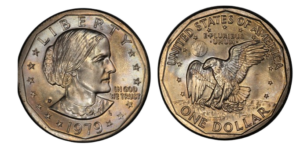
Photo by PCGS
2. “Super rare 1979 “P” Susan B Anthony one dollar coin” struck on quarter
An excellent response to the question “Why is a 1979 Susan B Anthony coin rare?” comes in the form of this special error coin. The 1979-P Susan B. Anthony dollar struck on a quarter resulted from a mix-up in planchets at the Philadelphia Mint. The error on the coin occurred when a planchet intended for the quarter-dollar, which is slightly smaller and thinner than the planchet used for the Susan B. Anthony dollar, was mistakenly fed into the press for minting the dollar.
This discrepancy in planchet size and thickness led to a coin with a reduced diameter and altered edge. Additionally, the overstrike error caused overlapping designs on this rare Susan B Anthony coin 1979 dollar, resulting in it showing features from the quarter, including the eagle’s feathers on the profile. This unique combination of distinctive features contributes to the coin’s high value among collectors.
1979-P Susan B. Anthony Dollar Struck on a Quarter
- Metal: Copper-Nickel
- Year: 1979
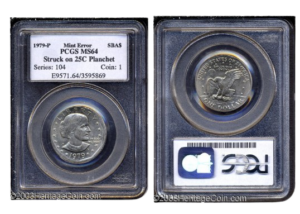
Photo by Heritage Auctions
3. Very rare 1980 Susan B Anthony one dollar coin (circulated) on nickel planchet
Even in 1980, the year following the introduction of the Susan B. Anthony dollar, minting errors persisted, including notable anomalies like this coin struck on a nickel planchet. Resulting from a mix-up at the San Francisco Mint, this 1980-S Susan B Anthony rare coin error makes for a valuable addition to any numismatic collection.
Typically, Susan B. Anthony dollars are struck on a cupronickel planchet composed of 91.67% copper and 8.33% nickel, but this coin was minted using a planchet intended for the five-cent nickel, which has a composition of 75% copper and 25% nickel.
The resulting coin, in addition to its different metal composition, has a noticeably different color compared to standard Susan B. Anthony dollars. This is because the nickel planchet gives it a distinct silver appearance.
1980-S Susan B. Anthony Dollar Struck on a Nickel Planchet
- Metal: Copper-Nickel
- Year: 1980
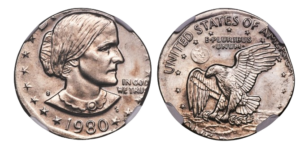
Photo by Heritage Auctions
4. Rare 1981 Susan B Anthony coin in Gem condition
The 1981-S Susan B. Anthony dollar in Gem condition represents a high-quality example of the series and its third lowest mintage coin. Struck at the San Francisco Mint, this coin is exceptionally difficult to find in condition MS64 and above, making it sought after by collectors for its rarity and pristine quality.
Collectors also value circulated 1981-S dollar coins in exceptional condition for their sharp, clear strikes and minimal imperfections. In Gem condition, these coins exhibit exceptional eye appeal with a high level of shine and crisp design elements. Due to its limited mintage and superior condition, the 1981-S dollar is considered one of the rarest Susan B. Anthony coin dollars, commanding significant interest and premium prices in the numismatic market.
1981-S Susan B. Anthony Dollar
- Metal: Copper-Nickel
- Year: 1981
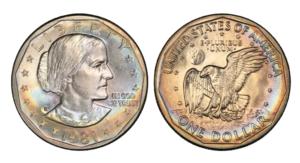
Photo by PCGS
5. An extraordinary 1981 Susan B Anthony coin/ rare proof dollar
Designed by renowned engraver Frank Gasparro, the 1981-S Proof Type II Susan B. Anthony dollar is an important variety of the coin series. Produced in limited numbers at the San Francisco Mint, this coin’s Type II designation refers to the difference in the appearance of its “S” mintmark compared to Type I. In the Type II version, the “S” appears bulbous, while in Type I it is less clearly defined and takes the form of a rounded rectangle.
Much like part of the answer to the question “What makes a Susan B Anthony 1979 coin rare?” is unique design features, the same stands true for the 1981-S Type II proof. The distinctiveness of the Type II mintmark adds to the coin’s appeal and rarity among collectors.
1981-S Proof Type II Susan B. Anthony Dollar
- Metal: Copper-Nickel
- Year: 1981
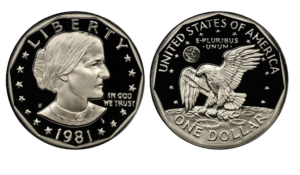
Photo by NGC
6. A rare Susan B Anthony coin from 1999
A shining example of an answer to the question “Is the Susan B Anthony coin rare?” is this 1999 error piece. While the Susan B. Anthony dollar was discontinued after 1981 due to its lack of popularity, it had a brief comeback in 1999. That year, its production resumed as a transitional measure to help familiarize the public with the new Sacagawea dollar. However, even during this short period, errors occurred, adding a layer of rarity and intrigue to these coins.
The 1999-P Susan B. Anthony dollar struck on a Sacagawea planchet is a highly sought-after error coin resulting from a mix-up at the Philadelphia Mint. The error occurred when a Sacagawea planchet was mistakenly used in the minting press intended for the Susan B. Anthony dollar. As a result, the coin bears the design of the Susan B. Anthony dollar but has the golden hue and weight characteristic of the Sacagawea dollar planchet. This anomaly creates a visually unique and collectible piece.
1999-P Susan B. Anthony Dollar Struck on a Sacagawea Planchet
- Metal: Brass
- Year: 1999
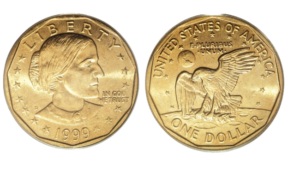
Photo by Heritage Auctions
To browse through extraordinary pieces such as rare Susan B Anthony dollar coins and more, click here.
FAQ about rare Susan B Anthony coins
Here is a rundown of the answers to the most frequently asked questions about Susan B. Anthony dollars.
What does “Susan B Anthony” mean?
“Susan B. Anthony” refers to an American suffragist and civil rights leader, renowned for her vital role in the women’s suffrage movement. In numismatics, her name is associated with the dollar coin minted from 1979 to 1981 and briefly in 1999, honoring her contributions to women’s rights.
Are Susan B Anthony coins rare?
Specific varieties of Susan B. Anthony dollars and error coins, like those struck on incorrect planchets or with unique design features, are considered rare and are sought after by collectors.
How rare are Susan B Anthony coins?
Certain rare varieties of Susan B Anthony coins can sell and have sold for tens of thousands of dollars at auction.
How rare is a 1979 Susan B Anthony dollar coin?
Specific varieties of the 1979 Susan B. Anthony dollar can be very valuable and are highly coveted by collectors.
What is the rarest Susan B Anthony coin?
One of the rarest Susan B. Anthony coins is the 1979-P dollar struck on a quarter planchet.
How do you tell if you have a rare Susan B Anthony coin?
To identify a rare Susan B. Anthony coin, look for key factors such as minting errors, low mintage years, or distinctive design variations.
Susan B. Anthony’s significant role in American history is reflected in the coins minted to honor her. These coins, particularly the rarer varieties and error pieces, hold substantial value and are treasured by collectors.
For acquiring Anthony coins and other numismatic treasures, choose Blanchard. With decades of experience and a reputation for excellence, Blanchard offers unparalleled expertise and a comprehensive selection. For inquiries and expert guidance on Susan B Anthony rare coins and more, Blanchard’s knowledgeable team is always available to assist you in your collecting journey.
Want to read more? Subscribe to the Blanchard Newsletter and get our tales from the vault, our favorite stories from around the world and the latest tangible assets news delivered to your inbox weekly.
The Adventurous Story Behind the SS Central America Gold Coins
Posted onThe SS Central America played a pivotal role in U.S. history by sparking the Panic of 1857, widely recognized as the first global financial crisis. Dubbed the “Ship of Gold” for the immense quantity of precious metals it carried, ranging from coins to ingots, the vessel’s tragic sinking had far-reaching effects that shaped the nation’s future. This article will discuss the recovery of the vessel’s lost treasure, focusing on SS Central America coins and highlighting:
- The most interesting SS Central America facts
- The highest-value coins from the SS Central America shipwreck
- Where to buy SS Central America coins and other rare pieces
Learn more about the SS Central America gold recovery operation in this fascinating video:
Facts about S.S. Central America, known as the ship of gold
While most people associate this iconic vessel with the economic crisis sparked by the loss of its significant SS Central America gold value, there’s far more to its story, including important facts from before and after it was wrecked. Here, we outline some of the most compelling ones.
S.S. Central America size
Built by the renowned Webb shipyard, the SS Central America was a large steamship with a 40-foot beam and a length of approximately 280 feet. It had a gross tonnage of around 2,141 tons, reflecting its significant capacity, which allowed it to carry substantial cargo and numerous passengers across the Atlantic.
SS Central America route
The SS Central America regularly sailed between the East Coast of the United States and Central America. The ship’s typical route was integrated into a wider transportation network designed to support and manage the increased travel and trade associated with the gold rush. On the day of its sinking, the SS Central America was on a voyage from Aspinwall (now Colón), Panama to New York City via Havana, Cuba.
SS Central America shipwreck location
The exact SS Central America location remained unknown until it was discovered in 1988, despite extensive searches and speculation about its position. The ship was found on the Atlantic floor near the western edge of the Gulf Stream, approximately 160 miles east of Charleston, off the coast of South Carolina.
SS Central America wreck depth
The SS Central America depth is approximately 2,200 meters (about 7,200 feet) on the Atlantic Ocean floor. This significant depth places it well below typical recreational diving limits, requiring advanced deep-sea exploration technology to reach and investigate the site.
SS Central America wreck photos
The SS Central America recovery mission has been thoroughly documented. Photos from SS Central America taken by the recovery team reveal detailed views of the artifacts and wreck site.
Interestingly, in addition to the precious metals and coins found on the shipwreck, actual photographs were also discovered. These include daguerreotypes and ambrotypes, i.e. early photographic methods using metal and glass plates, respectively. Remarkably preserved due to their protective cases and the ocean floor’s cool, dark conditions, these images feature miners, families, and passengers, offering a poignant glimpse into the lives aboard the ill-fated vessel. These photos were published for the first time in 2022.
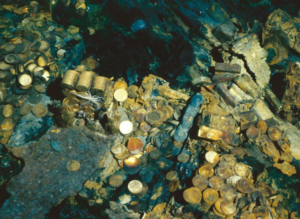
Photo by USA Today
SS Central America search
The SS Central America was located by the Columbus-America Discovery Group, led by Tommy Gregory Thompson, on September 12, 1988, using Bayesian search theory. A remotely operated vehicle (ROV) identified the wreck, and another ROV was used to recover significant amounts of gold and artifacts.
In March 2014, Odyssey Marine Exploration was contracted for the archaeological recovery and conservation of the remaining wreck. The “Odyssey Marine SS Central America” project aimed to explore and preserve the portions of the shipwreck that were not excavated during the initial recovery missions.
SS Central America survivors
When it went underwater, SS Central America became the site of one of the deadliest maritime disasters of the 19th century. Of the 578 people aboard the ship, over 400 lives were lost, including the captain and most of the crew.
Approximately 150 survived the sinking, including all the women and children. The survivors were mostly rescued by the steamship Mason after enduring the disaster. They faced challenging conditions in lifeboats and on makeshift rafts before being saved.
SS Central America coin inventory
The wreck of the SS Central America yielded approximately 10,000 coins, including thousands of freshly minted Double Eagles, and a variety of other rarities. Today, these coins are even more coveted than they were in their own time. SS Central America coins for sale are highly sought after by collectors for their allure as pre-1933 coins, prized for their historical significance and exceptional craftsmanship. Here, we highlight five of the most valuable coins discovered in the wreckage.
1. 1857-S $20 SS Central America coin
The 1857-S Double Eagle SS Central America coin is a notable numismatic treasure, particularly prized for its connection to the California Gold Rush. Struck at the San Francisco Mint, this coin features the Liberty Head design.
Approximately 5,400 of these freshly struck Double Eagles were recovered from the wreck, many in exceptional condition. Before this discovery, the finest examples of Type I Double Eagles from the San Francisco Mint were typically graded only in the AU range.
The 1857-S SS Central America coin’s high value today reflects its pristine condition and its unique place in American coinage history.
1857-S Liberty Head Double Eagle
- Metal: Gold
- Year: 1857
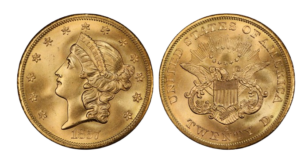
Photo by PCGS
2. 1854-O $2.50 S.S. Central America gold coin
The 1854-O Quarter Eagle is another remarkable piece among S.S. Central America shipwreck gold coins. Produced by the New Orleans Mint, this coin had a relatively high mintage of 153,000 pieces, making it a fairly common date.
However, what makes the 1854-O $2.50 coin from the SS Central America particularly special is its exceptional state of preservation. Coins from this era, especially those minted in New Orleans, often show considerable wear, but examples recovered from the wreck are in remarkably high grade, thanks to the protective environment of the ocean floor.
1854-O Liberty Head Quarter Eagle
- Metal: Gold
- Year: 1854

Photo by PCGS
3. 1852 $50 Humbert S.S. Central America gold coin
One of the most extraordinary S.S. Central America gold coins, this 1852 $50 gold piece is an octagonal ingot, also known as a “slug”. The coin’s large size and weight made it ideal for significant transactions during the Gold Rush, but it also led to many being melted down over the years, making surviving examples particularly scarce.
This hefty coin was the final piece minted by Augustus Humbert, the United States assayer of gold in California, which contributes to its status as a highly sought-after relic of the Gold Rush era. The coin’s reeded edge further distinguishes this piece from other Humbert $50 coins, adding to its desirability among collectors.
1852 Augustus Humbert $50 with Reeded Edge
- Metal: Gold
- Year: 1852
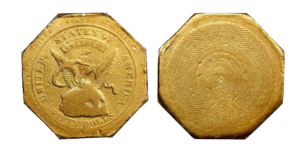
Photo by PCGS
4. 1847-O Half Dollar SS Central America treasure
The discoveries on the S.S. Central America wreck were not limited to gold. Collectors can also find numerous SS Central America silver coins for sale that are truly worth the investment.
A prime example is this 1847-O Liberty Seated Half Dollar. Minted in New Orleans, this coin is highly valued for its scarcity, with only a limited number of surviving examples. The exceptional preservation of these coins from the S.S. Central America makes them greatly desirable in numismatic circles, adding significant value and allure to any collection.
1847-O Liberty Seated Half Dollar
- Metal: Silver
- Year: 1847
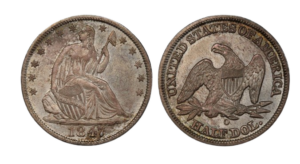
Photo by PCGS
5. One of the rare 1853 SS Central America dimes
Another silver S.S. Central America treasure is the 1853 Liberty Seated Arrows dime. This coin is notable for the arrowheads flanking the date, a design feature introduced that year to indicate a reduction in the coin’s weight due to rising silver prices. This change helped distinguish the newer, lighter coins from earlier versions, which were being melted down for their higher intrinsic value.
With a production run of over 12 million coins, this dime is widely available in most conditions, though top-grade examples, such as the ones from the S.S. Central America, are much rarer.
1853 Liberty Seated Arrows Dime
- Metal: Silver
- Year: 1853
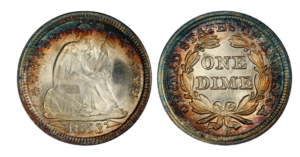
Photo by PCGS
To browse through rare coins beyond SS Central America inventory, click here.
Other SS Central America artifacts
In addition to the vast array of coins, the SS Central America shipwreck yielded numerous other significant gold artifacts. Among these were over 500 large gold bars, produced by assayers of the Gold Rush. Some SS Central America gold ingots were reported to weigh as much as 1,000 ounces.
The ship also carried hundreds of gold nuggets, weighing between 0.031 to 0.40 grams. These SS Central America gold nuggets were considered extremely valuable, as they represented a raw form of gold extracted from mining operations, capturing a direct link to the period’s mining endeavors.
Additionally, gold dust, which was collected from mining operations and stored in small containers, was found scattered among the wreckage.
The discovery of SS Central America gold dust, totaling approximately 36 kilograms, adds another layer of historical richness to the shipwreck, highlighting the extensive gold production and trade practices of the era.
FAQ about S.S. Central America coins
Here are the answers to people’s most common questions about SS Central America shipwreck coins.
Where did the SS Central America sink?
The SS Central America sank off the coast of South Carolina, approximately 160 miles east of Charleston.
How deep is the SS Central America?
The SS Central America lies approximately 2,200 meters (7,200 feet) deep on the Atlantic Ocean floor.
Who found the SS Central America?
The SS Central America was discovered by the Columbus-America Discovery Group led by Tommy Gregory Thompson in 1988.
How much gold was on the SS Central America?
The SS Central America carried an estimated 21 tons of gold, including coins, ingots, and dust, at the time of its sinking.
How much gold was recovered from the SS Central America?
The SS Central America gold recovery included over 7,000 gold coins, 800 ingots, and approximately 36 kilograms of gold dust.
Is there still gold on the SS Central America?
While significant amounts of gold were recovered from the SS Central America, estimates suggest that additional coins and artifacts might still be present in the wreck.
Gold from the SS Central America represents a remarkable chapter in numismatic history, with its exquisite coins and artifacts continuing to captivate collectors. For those interested in acquiring these rare pieces or exploring other exceptional numismatic opportunities, Blanchard is your premier resource. Renowned for its expertise and extensive inventory of rare coins, Blanchard offers unparalleled guidance and support. Whether you have questions about shipwreck coins, SS Central America or need advice on other numismatic investments, Blanchard’s knowledgeable team is always available to assist you.
Want to read more? Subscribe to the Blanchard Newsletter and get our tales from the vault, our favorite stories from around the world and the latest tangible assets news delivered to your inbox weekly.
The World’s Most Famous Rare Coin Collectors
Posted onIn the world of numismatics, a select group of individuals has left an indelible mark. With unwavering dedication and unparalleled expertise showcased in their extraordinary rare coin collections, they’ve crafted a legacy that continues to inspire modern-day collectors. This article will introduce some of the most famous old coin collectors, highlighting:
- The contributions of renowned rare coin collectors to the field of numismatics.
- Notable treasures within their collections.
- The most reputable avenue for acquiring coins as a contemporary old coins collector.
Watch this amazing video for intriguing personal stories about some of the world’s greatest numismatists:
List of rare coins collectors
In the fascinating realm of collectibles, rare stamps, coins, art, and antiques are items on which investors can make a large profit. Rare coins, in particular, attract dedicated collectors, some of whom have made significant contributions to numismatics. The following individuals are known for their legendary collections and profound impact on the field.
1. Joseph J. Mickley: one of the nation’s pioneering old coins collectors.
Joseph Mickley, one of America’s most important numismatists, shaped the field of coin collecting. A man of many interests, he excelled as a piano manufacturer and musical instrument repairman until his passion for collecting old coins took over.
In 1817, he began searching for a cent from his birth year, 1799, one of the most elusive large cents, sparking his lifelong dedication to numismatics. This interest led him to found the Numismatic Society of Philadelphia in 1857 and write several influential books on the subject.
He became an honorary member of the American Numismatic and Archeological Society, which would later become known as the American Numismatic Society, in 1867. For his contributions, U.S. Mint curator William E. Dubois dubbed him the “Father of American Numismatics.” Mickley’s extensive travels enabled him to collect many significant coins from both the U.S. and Europe, inspiring many collectors of old coins. One notable piece from his collection is this special piece:
1827 50C, CAM PR66CAM
- Metal: Silver
- Year: 1827
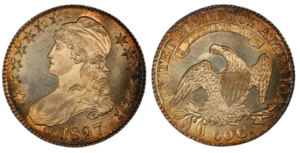
Photo by PCGS
2. Virgil M. Brand: among the most esteemed rare coin collectors of all time.
The son of a German father, Virgil Brand was born in Blue Island, Illinois. He worked as a bookkeeper for his father’s successful brewery business before becoming president of the United States Brewing Company and establishing the Brand Brewing Company.
Brand began collecting coins in 1889, and his financial success enabled him to amass an extraordinary collection of 350,000 coins from all around the world. As an old coin collector/buyer, he was a true scholar of numismatics and approached the field with an academic zeal. As a member of the Chicago Numismatic Society, where he served as librarian and curator, Brand contributed to The Numismatist and was frequently consulted to authenticate coins.
Among the treasures in his incredibly valuable collection was this remarkable specimen:
1875 $5 J-1438, CAM (Proof)
- Metal: Gold
- Year: 1875
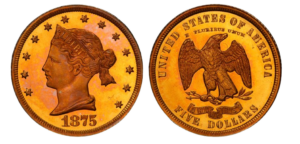
Photo by PCGS
3. Edward Howland Robinson Green: a notable collector of old coins.
Edward Howland Robinson Green, a prominent numismatist and renowned old coins & money collector, was the only son of the famous eccentric financier Hetty Green. Known as the “Witch of Wall Street” and the richest woman in America during the Gilded Age, Hetty left her vast fortune to her son. Unlike his frugal mother, E.H.R. Green was extravagant, spending his inheritance on lavish indulgences such as yachts, cars, exotic flowers, and his collecting interests.
Despite his success as a businessman, Green’s legacy lies in his remarkable collections. His stamp collection was considered the second greatest of the early 20th century, only behind that of King George V. His numismatic collection, valued at $5 million at the time of his death, included significant pieces such as this one:
1834 1/2C Cohen 1, RB (Proof)
- Metal: Copper
- Year: 1834
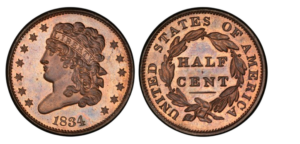
Photo by PCGS
4. The Garrett family: rare coin collectors and Johns Hopkins benefactors.
The Garrett family is considered one of the world’s most significant rare old coin buyers. Their remarkable coin collection was started by T.Harrison Garrett, who came from a prominent Baltimore family.
Due to an accident that limited his physical activity in childhood, his parents encouraged him to pursue hobbies in the arts and academia, including coin collecting. Garrett developed his interest in numismatics as a student at Princeton in the 1860s, with a New Jersey copper being among his first acquisitions. After a distinguished diplomatic career in Europe, he dove deeper into this hobby, amassing a great collection of coins that he left to his sons Robert and John. Deeply passionate about numismatics, John expanded the collection in the 1920s to include ancient, American, European, and Asian coinage.
The Garretts’ Baltimore home at Evergreen House, along with their coin collection, was bequeathed to Johns Hopkins University in 1941, which later sold the ancient coins in three sales held in 1984 and 1985.
5. King Farouk I of Egypt: an eccentric royal rare coins buyer.
Within the vast amount of rare coin collectors‘ stories, King Farouk’s stands out as an exceptionally captivating one. As Egypt’s last king from 1936 to 1952, Farouk earned the moniker “playboy king” for his lavish lifestyle. With access to Egypt’s treasury, he pursued extravagant interests like collecting art, cars and coins.
Capitalizing on the Great Depression, a time when many collectors in the US were forced to liquidate assets, Farouk managed to amass an impressive collection of over 8,500 coins, including an extremely coveted 1933 Double Eagle. Following his ousting in 1952, the Egyptian government auctioned off his collection, which today is estimated to be worth over $150 million.
6. Josiah K. Lilly, Jr.: a renowned rare coin collector and Smithsonian patron.
Josiah K. Lilly Jr. was born into a distinguished family of pharmacists and followed in their footsteps, eventually inheriting the Lilly Pharmaceuticals firm. However, while he achieved significant success in his business pursuits, his lasting legacy lies primarily in his contributions to numismatics.
As is the case with other collectors, old coins fascinated Lilly. His journey in the field began modestly when, as a child, he found a Lincoln cent, igniting a lifelong passion. Over time, his dedication grew, leading him to assemble one of the most valuable private coin collections in the United States.
A collector of books and manuscripts, Lilly was intellectually curious and contributed extensively to the numismatic community through publications and exhibitions, sharing his knowledge. Following his passing in 1966, his collection of 6,113 coins was entrusted to the Smithsonian Institution, where visitors can still appreciate his legacy through remarkable pieces like this one:
1787 1/2 Db Brasher (Regular Strike)
- Metal: Gold
- Year: 1787
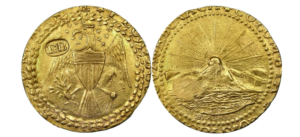
Photo by PCGS
7. John Jay Pittman: one of the most prominent American rare coin investors.
A man of humble origins from North Carolina, John Jay Pittman was driven by a profound appreciation for the beauty and historical significance of coins. Unlike many investors who buy rare coins for their future value and other collectors mentioned here, who amassed collections with their substantial wealth, Pittman was the son of a teacher and a railroad worker. He diligently worked and saved throughout his life, employing savvy techniques in his collecting endeavors.
Pittman was renowned for his patience, avoiding big auctions and meticulously researching undervalued and obscure coins. His keen eye for rarities was legendary. Notably, he even mortgaged his house to acquire the 1838 Proof Ten Dollar Gold Piece at King Farouk’s auction in Cairo in 1954.
Pittman’s collection, acquired for less than $100,000, realized over $25 million in sales during auctions held in 1997 and 1998, cementing his legacy in numismatics.
8. Louis E. Eliasberg: an unmatched old coin collector.
A successful financier from Alabama, Louis E. Eliasberg Sr. is famous for assembling the only complete collection of United States coins in history.
Beginning in 1925, Eliasberg embarked on a mission to acquire every regular-issue coin of every date, metal, denomination, and mint mark produced by the U.S. Mint. In 1950, he achieved this monumental feat, culminating with the acquisition of the 1873-CC no arrows dime. His collection, which did not differentiate between proofs and strikes or specify die variations like modern collections, remains unmatched in comprehensiveness to this day.
Following his death in 1976, the Eliasberg collection was dispersed through auctions by Bowers and Merena Galleries from 1982 to 1997. Today, many pieces are held in private hands and prestigious numismatic institutions worldwide, cherished by rare coin buyers and historians alike.
9. Harry W. Bass Jr.: a distinguished gold rare coin buyer.
Harry W. Bass Jr., an American businessman and philanthropist, earned his fortune in the oil and gas exploration industry amidst the Texas oil boom. Alongside his business pursuits, he became renowned in numismatic circles for his expertise in highly sought-after old collectors’ coins, mostly U.S. gold coins and patterns.
Bass’s numismatic journey began in 1965 when he purchased a roll of quarters at face value and realized he could later sell them for profit. Fourteen years later, having invested millions in rare coins, he became the president of the American Numismatic Society.
Bass’s collection, amassed over decades, evolved into one of the most significant compilations of US gold coins in history and was showcased at the Money Museum from 2001 to 2022. Today, portions of it, like this extraordinary specimen, are preserved at the American Numismatic Association Museum and the Harry W. Bass Jr. Research Foundation, where they continue to serve as a source of inspiration for collectors:
1838 Judd-77 Pattern Half Dollar
- Metal: Silver
- Year: 1838
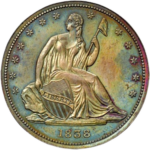
Photo by NGC
10. Bob Simpson: among the most legendary buyers of rare coins.
A highly successful entrepreneur, Bob Simpson is the co-founder of XTO Energy and co-chairman of the Texas Rangers Major League Baseball (MLB). But unlike other affluent businessmen who began collecting coins after amassing wealth, Simpson’s fortune merely allowed him to deepen a passion he had nurtured since childhood, when he regularly visited banks in search of Mercury dimes and rare pennies.
An old coin collector at heart, Simpson’s collection features an impressive array of U.S. pattern coins and exceptional proof coins, showcasing rare and unique pieces that reflect his discerning taste and profound knowledge of numismatic history. The Professional Coin Grading Service (PCGS) has ranked his collection as one of the finest ever amassed.
If you’ve been inspired by these famous rare old coin buyers, browse through Blanchard’s exclusive selection of numismatic rarities.
Where do old coins collectors buy their coins?
Famous coin collectors like Eliasberg, Bass, and Simpson have made significant impacts on the numismatic world. These individuals have shown how passion and dedication can lead to remarkable achievements in coin collecting.
If you are inspired to start or expand your collection, Blanchard offers an exclusive selection of rare coins. For all inquiries related to rare coin collectors and beyond, contact Blanchard’s team today. Blanchard’s expert professionals are always available to help you build a distinguished collection, offering unmatched expertise and guidance.
Want to read more? Subscribe to the Blanchard Newsletter and get our tales from the vault, our favorite stories from around the world and the latest tangible assets news delivered to your inbox weekly.
Gold and Silver Emerge as Big Third Quarter Winners
Posted onAs the days get shorter, the temperatures turn cooler and pumpkin spice everything is everywhere, gold and silver emerged as clear asset class winners in the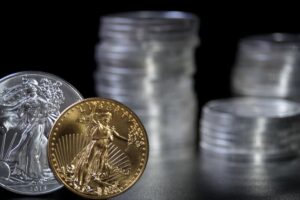 third quarter. Amid escalating war in the Middle East, the start of the Federal Reserve rate cutting cycle and uncertainty about the U.S. presidential election investors are piling into the safety of gold and silver.
third quarter. Amid escalating war in the Middle East, the start of the Federal Reserve rate cutting cycle and uncertainty about the U.S. presidential election investors are piling into the safety of gold and silver.
Precious Metals Performance
In September, gold broke records again hitting a new all-time at $2,670 an ounce, while silver soared to a 12-year high at $32.00 an ounce. Gold is up 24% since the start of the year and silver has gained 28%.
Mideast War Heats Up
The match has been lit in the Mideast and the fire could blaze out of control at any time. At the end of the third quarter, it became clear the Mideast conflict is expanding as the war has widened to not only include Israel and Hamas but also Iran and Lebanon. War can create scenarios that spark big sell-offs in stocks, which is another factor supporting fresh inflows into gold as a safe-haven.
Fed Starts Historic Rate Cutting Cycle
The start of the Federal Reserve’s rate cutting cycle in September sparked a dramatic rally in gold—pushing the precious metal to another record high. The Fed went big with its first interest rate cut of this cycle with a jumbo sized half percent cut, bringing the Fed’s benchmark rate to 4.75% to 5.00%. This marked the first interest rate cut in four years.
In the Fed’s policy statement, it explained the move reveals “greater confidence that inflation is moving sustainably toward 2%” and that the central bank “judges that the risks to achieving its employment and inflation goals are roughly in balance.”
The Fed is expected to continue cutting interest rates through the rest of the year – including at the November meeting in the same week as the presidential election.
What does this mean for metals investors? Gold trends higher for nearly two years once the Fed begins cutting interest rates. Research from the Wells Fargo Investment Institute reveals that the start of Fed rate cutting cycles are extremely positive for gold ahead: “The average price of gold has tended to rise quite nicely and for nearly 21 months, following the start of past Fed interest-rate easing cycles.”
Jobs Market Running Out of Gas
The latest government data reveals that job growth is slowing. Over the past three months, the number of new non-farm jobs fell from an average of 250,000 per month in 2023 to just 116,000 new jobs per month.
The high level of interest rates has been one factor weighing on job growth and is slowing the overall economy. Employers have pulled back on hiring as high interest rates has slowed consumer buying of big-ticket items from homes to cars to furniture. The slower consumer demand hurts profit margins, so employers pull back on new job creation. This adds fuel to speculation that the Fed may need to continue to go big with future interest rate cuts and may need to slash rates by another half percent at its November 6-7 meeting.
Consumer Confidence Plummets
Worries about jobs drove the September Consumer Confidence Index sharply lower to 98.7 from 105.6 in August, the Conference Board said. The September plunge in consumer confidence marked the biggest drop since August 2021 and showed deterioration in all five components of the index. Americans worry about the upcoming U.S. Presidential election, the increasing military conflict around the globe, and the still high cost of everyday items like food and interest on loans for homes, cars and credit cards.
Polarized Nation Set to Vote for President in November
Another factor injecting uncertainty into the financial environment is the November presidential election. Polls reveal a near dead heat between Donald Trump and Kamala Harris. And investors and Wall Street are bracing for what could be two extremely different policy directions on issues like taxes and trade and what those policies could mean for the economy ahead.
This all adds up to a stock market vulnerable to big swings up and down. That’s another reason that investors have been piling into gold this year. Gold provides protection and wealth preservation against a number of unforeseen events that could cause other asset classes to tumble. Consider this.
- During the 2001 dot.com stock market crash, the S&P 500 was down 47% and gold was up 16%.
- During the 2008 global financial crisis, the S&P 500 was down 55% and gold was up 21%.
The U.S. Government Debt and Gold
Gold has a proven track record over thousands of years as an asset that can preserve wealth. Today, affluent families and everyday Americans are turning to precious metals in greater numbers many reasons including protection against the historic and ever-rising levels of U.S. government debt.
Consider this: In 2024, the U.S. government debt has soared above $35 trillion, that’s up from $27.1 trillion in 2019.
Most concerning to many policy watchers is that the rising debt levels are occurring during peace time when the U.S. economy is growing. Historically, the debt rises during economic recessions, not periods of peacetime and economic growth. This leaves the U.S. vulnerable to an even bigger increase in the debt during the next recession.
Unlike the U.S. dollar, gold is a currency that is beholden to no national government and has no obligations or debts against its value. There is no counter-party risk when you own gold and a government can’t simply devalue gold or print more of it.
The Bottom Line
Gold is a clear winner in this environment. The start of the Fed easing cycle is positive for the precious metals complex and will help gold continue to power higher in the months ahead. New forecasts from Citi Research reveal analysts there say gold could reach $3,000 an ounce by mid-2025.
These forecasts reveal lots of performance gains ahead, meaning it is still an optimal time to increase your allocation to gold. Investors who own gold have done better than portfolios without gold over the past twenty years. Is your portfolio properly allocated to deliver maximum returns and maximum safety? If you aren’t sure, give us a call we are happy to help.
Want to read more? Subscribe to the Blanchard Newsletter and get our tales from the vault, our favorite stories from around the world and the latest tangible assets news delivered to your inbox weekly.
Consumer Confidence Plummets, Gold Hits Record High
Posted onWorries about jobs drove the September Consumer Confidence Index sharply lower to 98.7 from 105.6 in August, the Conference Board said.
Meanwhile investors continued to pile into gold driving the precious metal to another record high at $2,670 an ounce in late September.
The September plunge in consumer confidence marked the biggest drop since August 2021 and showed deterioration in all five components of the index. Big picture, Americans worry about the upcoming U.S. Presidential election, the increasing military conflict around the globe, and the on-going high cost of everyday items like food and interest on loans for homes, cars and credit cards.
Concerns about the labor market were a key factor in the confidence decline, the Conference Board said. In September, Americans were more pessimistic about future labor market conditions and less positive about future business conditions and future income.
Here’s some details:
- The Present Situation Index—based on consumers’ assessment of current business and labor market conditions—fell by 10.3 points to 124.3.
- The Expectations Index—based on consumers’ short-term outlook for income, business, and labor market conditions—declined by 4.6 points to 81.7
Looking ahead…
Falling confidence could lead to lower consumer spending. Consumer buying plans for big-ticket appliances were mixed and plans to buy a smartphone or laptop/PC in the next six months eased, the Conference Board said.
The United States economy is consumer based and consumer driven. Consumer spending drives almost 70% of total gross domestic product (GDP). That means if people are less confident and spend less, the economy will slow in the months ahead.
The dramatic drop in confidence surprised many on Wall Street and is a signal of the conflicting views between Main Street and Wall Street. In the meantime, investors continue to turn to the safety of gold and silver.
Precious Metals Performance
Gold has surged 29% higher in 2024 and silver is up 21%, with silver recently touching a new 12-year high. Gold is a proven portfolio diversifier which provides investors with protection against equity market declines. Research shows that gold becomes more negatively correlated to stocks during extreme market sell-offs. (That’s a good thing and means that when stocks crash, gold typically climbs.)
- Gold has been particularly effective during periods of systemic risk, generating positive returns in nine of the ten worst years of performance for the global equity index, according to new research from Goldhub.
The Bottom Line
Investors who own gold have done better than portfolios without gold over the past twenty years. Is your portfolio properly allocated to deliver maximum returns and maximum safety? If you aren’t sure, give us a call we are happy to help.
Want to read more? Subscribe to the Blanchard Newsletter and get our tales from the vault, our favorite stories from around the world and the latest tangible assets news delivered to your inbox weekly.







